#kalighat paintings.
Text
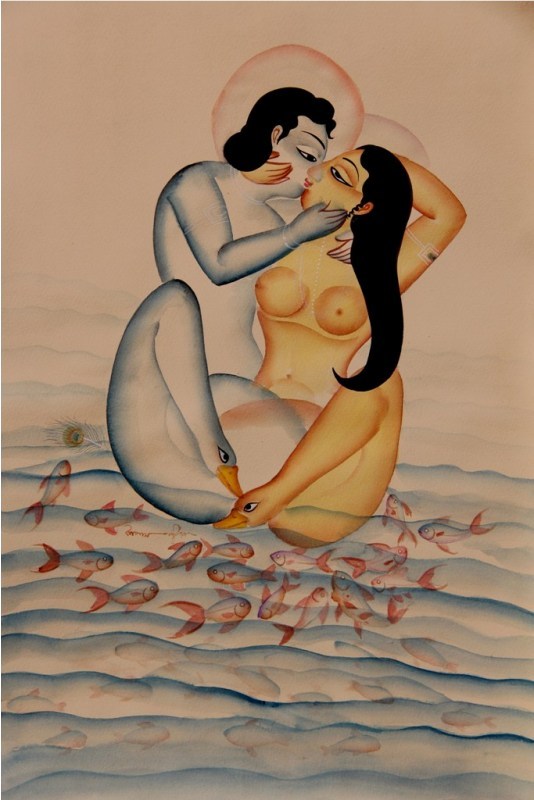
Kalam Patua
Renowned Kalighat painter, Kalam Patua was born on November 1, 1962 in Jhilli village, Murshidabad district of West Bengal. Kalam was born in the Patua community who skilled themselves as the scroll painters and wandered along the ghats of Kali temple in Kolkata in early 18th century to showcase their unique style of patachitra scroll paintings, which thereafter got the recognitions as kalighat paintings.
327 notes
·
View notes
Photo
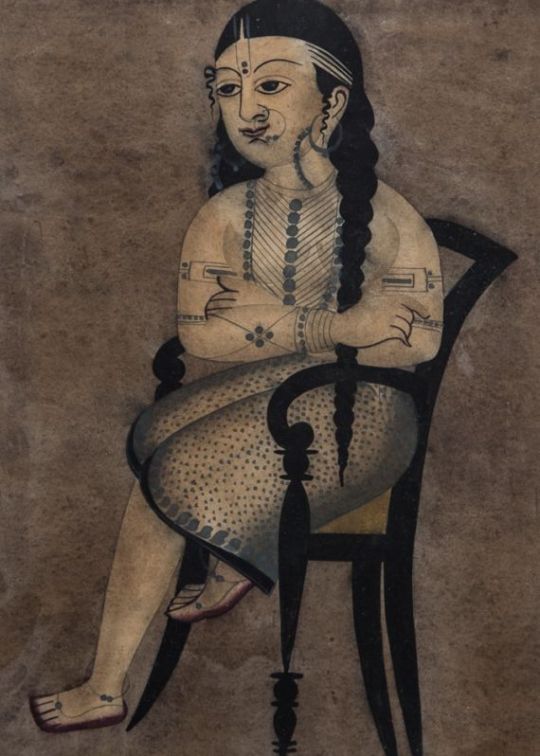
Kalighat Paintings: How a Rural Performance Art Shaped India’s Cultural Landscape
96 notes
·
View notes
Text
Kalighat painting, an extraordinary style of Indian folk art, originated in the 19th century within the vibrant Kalighat area of Kolkata (formerly Calcutta), West Bengal, India. It emerged during a period of profound social and cultural change in colonial India, and quickly gained popularity as a unique and expressive form of artistic expression.
0 notes
Text
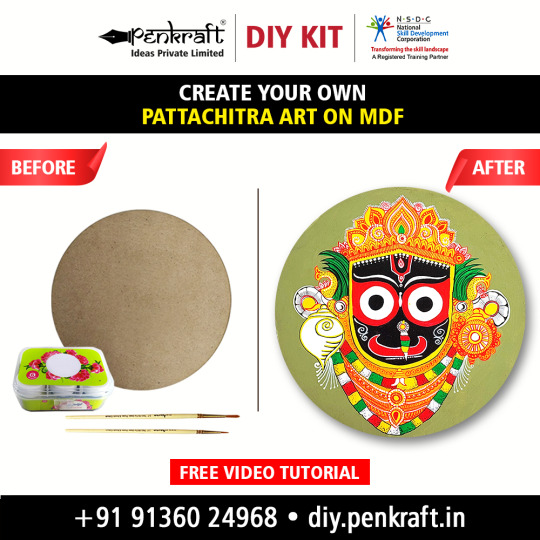
Penkraft's DIY Kits contain all material and tools that you need to undertake an art or craft activity - be it ethnic art forms, modern art forms or calligraphy.... And each DIY Kit comes with a Video Tutorial that teaches you how to use the material and create an amazing piece of art from ordinary objects!
#Penkraft DIY Kits#Pen Mandala DIY Kits#Resin Art DIY Kits#Fluid Art DIY Kits#Alcohol Ink DIY Kits#Dot Mandala DIY Kits#Gond Art DIY Kits#Warli Painting DIY Kits#Lippan Art DIY Kits#Decoupage DIY Kits#Image Transfer DIY Kits#Kalamkari DIY Kits#Kalighat DIY Kits#Knife Painting DIY Kits#Pop Art DIY Kits#One Stroke Painting DIY Kits#Brush Pen Calligraphy DIY Kits#Cut Nib Calligraphy DIY Kits#Devanagari Calligraphy DIY Kits#pattachitra art#art#artsy
0 notes
Photo
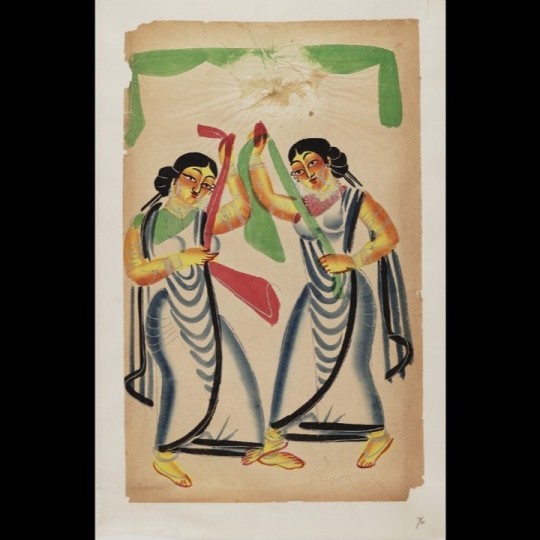
this #Kalighat #painting reminds song डोला रे डोला रे हाय डोला दिल डोला मन डोला रे from film Devdas! but Taifa Wali inscribed there? title is strange. folio 76, dt 1875 from @bodleianlibs @bodleianlibrary MS. Ind. Inst. Misc. 22 anyone knows Taifa? stands for in Bengali? my tweet https://twitter.com/kamlesm/status/1590950624145076224?s=20&t=MBB9MjP-rLyPyT6joQTBFA https://www.instagram.com/p/ClDMYr3pl4Y/?igshid=NGJjMDIxMWI=
0 notes
Text
Kalighat Paintings | Genuine Kalighat Paintings Online
https://www.artflute.com/collections/kalighat-paintings
Kalighat paintings are a type of Folk art that originated in Bengal, India. The paintings are usually creating using domestic objects such as matchboxes, combs, and bangles. The paintings typically depict Hindu deities or scenes from Hindu mythology.
Kalighat paintings are not only unique for their medium, but also for their style. The paintings are characterized by their use of bold colors and simple lines. The paintings are also characterized by their flat, two-dimensional perspective.
Kalighat paintings are not only unique for their medium and style, but also for their subject matter. The paintings often depict scenes of daily life, such as a mother nursing her child, or a farmer carrying his harvest. Other popular subjects include Hindu deities, such as Vishnu, Lakshmi, and Shiva. Kalighat paintings also often depict scenes from Hindu mythology, such as the story of Rama and Sita.
In addition to their unique subject matter, Kalighat paintings are also noteworthy for their use of humor. The paintings often depict comical scenes, such as a man being chased by a tiger, or a woman being chased by a husband. Kalighat paintings also frequently use satire to comment on social issues, such as corruption or poverty.
The Kalighat painting tradition originated in Bengal, India, in the early 19th century. The paintings were originally created as devotional offerings to Hindu deities, and were sold near the Kalighat temple in Kolkata. The paintings were typically created using domestic objects such as matchboxes, combs, and bangles.
The Kalighat painting tradition reached its peak in the mid-19th century. At this time, the paintings were characterized by their use of bold colors and simple lines. The paintings were also characterized by their flat, two-dimensional perspective.
In the late 19th century, the Kalighat painting tradition began to decline. This was due in part to the arrival of Western-style painting in India. However, the tradition has experienced a revival in recent years, with artists working in both traditional and contemporary styles.
Here’s how kalighat paintings are made -
Kalighat paintings are made by using a traditional technique that involves using natural dyes and pigments. The artist first sketches the outline of the painting on a piece of cloth or paper, and then fills in the details with the dyes and pigments. Once the painting is complete, it is typically mounted on a wooden frame and hung on a wall or door.
Kalighat paintings are not only beautiful works of art, but they also provide a glimpse into the culture and traditions of India. For example, many of the paintings depict Hindu gods and goddesses, as well as scenes from Indian folklore. Kalighat paintings are also often used as decoration in Indian homes and businesses.
Kalighat Paintings Today –
As demand for less expensive, commercially created images increased in the early 20th century, the practise of Kalighat painting started to disappear. Numerous patua families were left with no choice but to leave the city and return to the rural areas where their ancestors had originally resided, or to look for other types of employment. Today, kalighat painting is still practised in West Bengal's rural areas. Two such locations where the tradition of Kalighat painting has been preserved by modern painters are Medinipur and Birbhum. The paintings they produce focus on secular themes and current events as well as a variety of religions imagery, and are done in a modern way using organic dyes, just like the original 19th century patuas.
0 notes
Text

Krishna as Kali, worshipped by Radha.
"Krishna as Kali worshipped by Radha (recto), from a Kalighat album, c. 1890. Eastern India, Bengal, Kolkata, Kalighat. Gum tempera, graphite, and ink on paper; secondary support: 48.1 x 29.7 cm (18 15/16 x 11 11/16 in.); painting only: 25.4 x 20.4 cm (10 x 8 1/16 in.). The Cleveland Museum of Art, Gift of William E. Ward in memory of his wife, Evelyn Svec Ward 2003.113.a
Krishna’s cowgirl (gopi) Radha was Ayanaghosha’s wife, and her devotion to him transcended marital ties. Whenever Radha was together with Krishna and her husband appeared, Krishna instantly transformed himself into Kali and Radha into her devotee. Radha, a model devotee, symbolizes the human soul and its longing for god. Her willingness to break the rules of duty (dharma) exemplifies her devotion."
(Via)
71 notes
·
View notes
Text

'Tiger Woman'
(Kalighat painting). By Kalam Patua
#tiger#art#tiger woman#aesthetic#vintage#old school cool#style#beauty#indian art#kalam patua#vintage art
28 notes
·
View notes
Text

Sharadiya 2023 : Prathama
I know I know its already Dwitiya and I'm super late. But here's Shailputri!! Again, tried out Kalighat painting style and might keep doing so for the rest of these!
If Brahmacharini wills it, I'll maybe be on time tomorrow...
29 notes
·
View notes
Photo
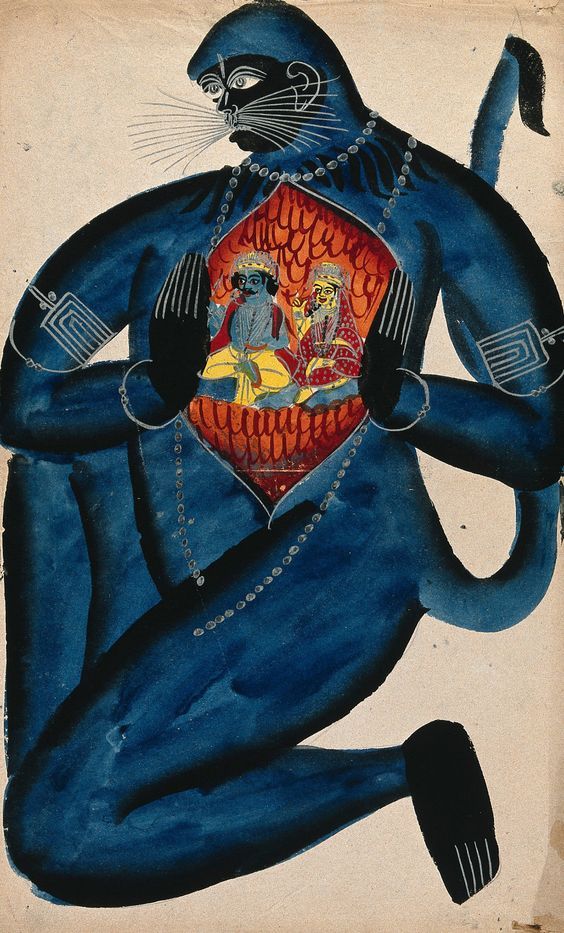
Unknown, Hanuman the monkey god, blessed with superhuman powers, rescues Rama (Vishnu) and his wife Sita from Ravana, king of Sri Lanka. When asked where he had hidden Rama and Sita, Hanuman replies 'In my heart'
watercolor, with pencil and silver ; sheet 45.8 x 28 cm
Kalighat painting is a school of painting in Kalighat, a small district in Calcutta. It is named after the Hindu goddess Kali. Kalighat painting originated from the folk art tradition of rural Bengal. The Patuas or picture makers had migrated from Bengal in the early nineteenth century. There are a range of subjects from religious imagery of Hindu gods, goddesses and stories to natural history, social types and proverbs. The range of materials used in drawing are pencil, watercolor, indian ink and silver paint
Welcome collection
675 notes
·
View notes
Photo

Painting / Kalighat, 19th - early 20th century x
Kalighat or painting, executed in watercolour on mill-made paper, depicting Krishna quelling the serpent Kaliya: Indian, Hindu, probably 19th or early 20th century
88 notes
·
View notes
Text

A woman pulling giant aubergines from a tree. Watercolour.
Notes
Kalighat painting is a school of painting in Kalighat, a small district in Calcutta. It is named after the celebrated Hindu goddess Kali. Kalighat painting originated from the folkart tradition of rural Bengal. The Patuas or picture makers had migrated from Bengal in the early nineteenth century. There are a range of subjects from religious imagery of Hindu gods, goddesses and stories to natural history, social types and proverbs. The range of materials used in drawing are pencil, watercolour, indian ink and silver paint
Wellcome Library no. 26113i
Exhibited in “Ayurvedic Man: Encounters with Indian medicine” at Wellcome Collection, 16 November 2017 – 8 April 2018
40 notes
·
View notes
Photo

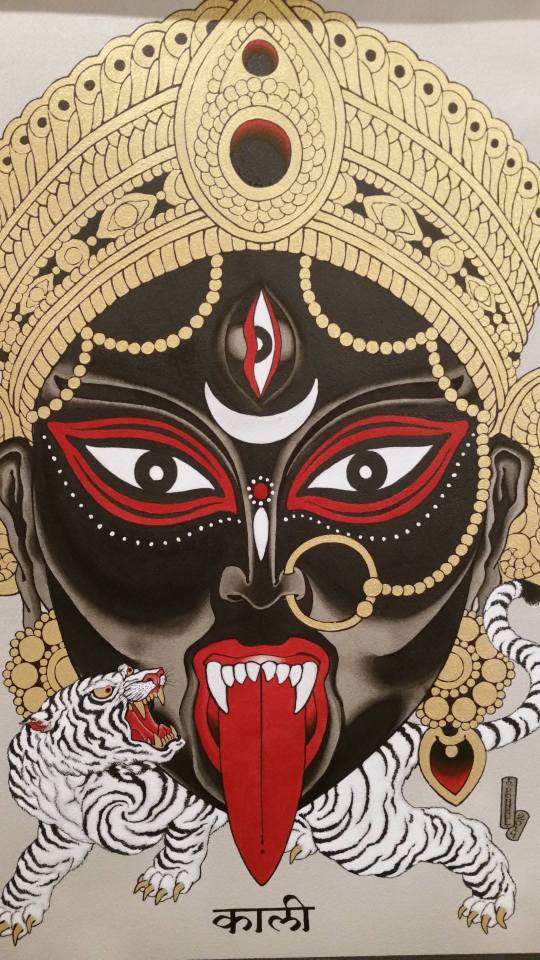
Mula Nakshatra
The presiding deity of Mula Nakshatra is Goddess Kali. Worship of Goddess Kali can be highly beneficial to the natives of this Nakshatra as she blesses the native to win the war against inner demons and gives them great creative abilities. Kalighat painting is a school of painting in Kalighat, a small district in Calcutta. It is named after the celebrated Hindu goddess Kali.
289 notes
·
View notes
Text

• 3 Square Coasters (4"X4")
• Acrylic Colors-Set of 6
• Brush No. 000 and 3 (One each)
• 2 Units of Air Dry Clay
• 1 Pkt of Mirrors (60Pcs)
• 1 Unit of Glue
• Free Video Tutorial
#Lippan Art DIY Kits#Decoupage DIY Kits#Image Transfer DIY Kits#Kalamkari DIY Kits#Kalighat DIY Kits#Knife Painting DIY Kits#Pop Art DIY Kits#Lippan art#Lippan art work
0 notes
Photo
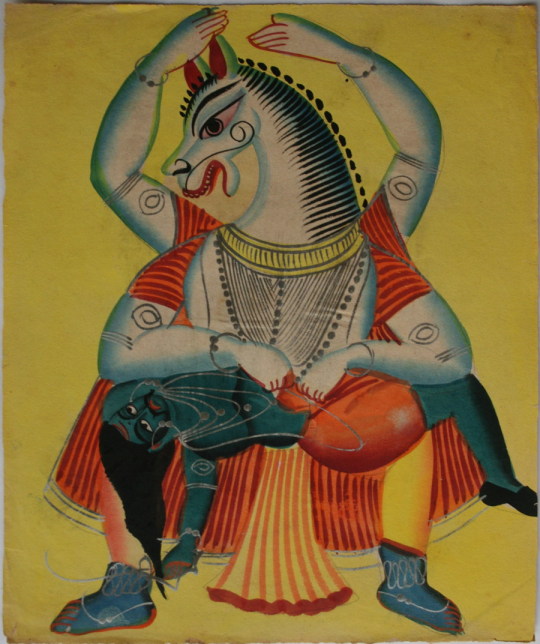
Narasimha, Kalighat painting, Kolkatta, Bengal
77 notes
·
View notes
Text
Resource Masterlist: Indian Art

Cheap/Free resources:
Wkipedia:
Wikipedia of Indian Art: I'll recommend reading the subtopics from bottom up; it seems more relevant that way!
Wikipedia of Indian Painting: once you go through this article you should further look into whichever style you like, and learn it in depth. It also has links to vernacular art.
Rasa: the classical theory of Indian aesthetics
From Archive.Org (maybe scholarly and/or illustrative. In case illustrations are not there, simply Google them for reference):
Stone Age Painting in India by Romert Brooks
The arts of India from prehistoric to modern times by Ajit Mookerji (If you have no idea about Indian arts, START HERE; it's a short book full of illustrations)
Rajput painting : romantic, divine and courtly art from India by Ahluwalia, Roda
Indian Painting by C Sivaramamurti
South Indian Paintings by C Sivaramamurti
Approach to nature in Indian art and thought by C Sivaramamurti
[There are many books on Indian art, architecture and sculpture by C Sivaramamurti on Archive.org. It's basically a goldmine.]
Kalighat : Indian popular painting, 1800-1930 by Balraj Khanna
Art of modern India by Balrak Khanna [Again, you can check out other titles by Khanna.]
Indian Textiles by John Gillow
Traditional Indian Textiles by John Gillow
South-Indian images of gods and goddesses by HK Sastri
Myths and symbols in Indian art and civilization by Heinrich Zimmer (no illustrations)
The art of Indian Asia, its mythology and transformations by Heinrich Zimmer (with illustrations)
History of Indian and Indonesian art by Ananda Coomaraswamy
A Concise History of Indian Art by Roy C Craven
Deccani Painting by Mark Zebrowski
Indian Folk Art by Heinz Mode; Subodh Chandra
Women of India by Otto Rothfeld (this isn't about art but has few informative illustrations on regional costumes of women)
Dress And Ornaments In Ancient India by Mohini Verma and Keya Bawa
Classical dances and costumes of India by Ambrose, Kay
Cultures and Costumes of India and Sri Lanka by Kilgallon, Conor (o course i had to see other books on costumes)
Studies In Indian Painting by DB Taraporevala
Five Thousand Years of Indian Art by Hermann Goetz
Indian Painiting by Philip Rawson
The Art of Tantra by Philip Rawson
MS Randhawa (different books on Punjabi paintings Basohli, Kangra, Guler and General Themes in Indian Painting)
The imperial image: paintings for the Mughal court by Beach, Milo Cleveland
Wonders of nature : Ustad Mansur at the Mughal court by Dāśa, Aśoka Kumāra
Imperial mughal painting by Welch, Stuart Cary
Painted delight : Indian paintings from Philadelphia collections
India : life, myth and art by Ram-Prasad, Chakravarthi
The heritage of Indian art by Agrawala, Vasudeva Sharana
The adventures of Rama : with illustrations from a sixteenth-century Mughal manuscript
Indian paintings from the Punjab Hills by WG Archer
Art in East and West by Rowland Benjamin
Stella Kramisch (An American art historian and curator who was a leading specialist on Indian art, including folk art, for most of the 20th century. Also a Padma Bhushan awardee.)
The transformation of nature in art by Coomaraswamy, Ananda K
Books available on Libgen:
Art Of Ancient India : Buddhist, Hindu, Jain by Huntington and Huntington
The New Cambridge History of India, Volume 1, Part 3: Mughal and Rajput Painting
Myths and Symbols in Indian Art and Civilization by Heinrich Zimmer
Four Centuries of Rajput Painting: Mewar, Marwar and Dhundhar Indian Miniatures from the Collection of Isabelle and Vicky Ducrot
Ajanta by Yazdani
The Aesthetic Experience Acording to Abhinavagupta
TheHeritageLab is a free website to connect you to cultural heritage through stories, public engagement programs, campaigns, and free-access content.
Also if you're in Delhi, do consider getting a membership of Indira Gandhi National Centre for the Arts (IGNCA) library.
Folk art:
Folk art is an entirely different area that deserve a post of its own. But i love them so here is a long list by Memeraki.com. You can Google each and then look more into what you like. This website also offers very cheap courses in traditional Indian arts by the hidden and disenfranchised masters themselves! It's doing a great work in giving them a platorm. I myself have taken the Mughal Miniature course here. You can consider it.
Illustrated Books:
Note: These are coffee table books with beautiful illustrations that you'd love to looks at.
The Night Life of Trees: In the belief of the Gond tribe, the lives of humans and trees are closely entwined. A visual ode to trees rendered by tribal artists from India, this handcrafted edition showcases three of the finest living Gond masters. THIS YOUTUBE LINK shows the making of the book. The channel also features other works of Gond art.
An Unknown Treasure in Rajasthan: The Bundi Wall-Paintings: This book celebrates the surviving wall-paintings at Bundi by presenting a stunning photographic survey
Painting In the Kangra Valley: Painting in the Kangra Valley is an attempt to survey the painting styles of Guler and Kangra, which flourished in the 18th and 19th centuries. The painting activity began with Kashmiri painters (...)
Indian Painting: The Lesser Known Traditions: India has an astonishingly rich variety of painting traditions. While miniature painting schools became virtually extinct with the decline of aristocratic patronage, a number of local vernacular idioms still survive and continue to develop.
Madhubani Art: Indian Art Series: Madhubani art's origin is believed to go back to the ancient era of the Ramayana, when the town was decorated by inhabitants of the region for the wedding of Lord Rama and Sita with elaborate wall paintings and murals (...) Primarily a significant socio-cultural engagement for the womenfolk of Bihar, this art was a welcome break from their daily drudgery.
Reflections on Mughal Art and Culture: Enter the splendid world of Mughal India and explore its rich aesthetic and cultural legacy through fresh insights offered by 13 eminent scholars.
Monsoon Feelings: A History of Emotions in the Rain: Through a series of evocative essays exploring rain-drenched worlds of poetry, songs, paintings, architecture, films, gardens, festivals, music and medicine, this lavishly illustrated collection examines the history of monsoon feelings in South Asia from the twelfth century to the present
Sita's Ramayana shifts the point of view of the Ramayana - the saga of a heroic war - to bring a woman's perspective to this timeless epic. Illustrated with Patua painting.
Adi Parva: Churning of the Ocean: a graphic novel that is a revisionist retelling of some of our oldest tales which have inspired and guided generations of people.
Ajit Mookerji, Sivaramamurti and Craven Roy's books are concise from where one can begin and then delve deeper into the subject of interest. Reading history and myths behind the work for context and listening to music from the given time/region alongside will make the exploration even more enjoyable!
#indian aesthetics#indian art#master post of indian art#desi#desi culture#desi aesthetic#indian dark academia#indian art history#indian art history books#indian art books
26 notes
·
View notes